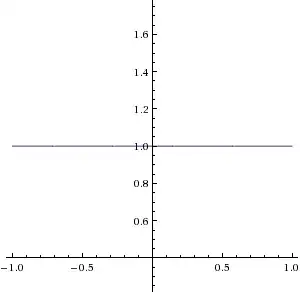We all know that $\dfrac{f(x)}{f(x)} = 1$ (where $f(x) \neq 0$) and that $\sum_{n=1}^{x} n = \dfrac{x(x+1)}{2}$.
So, given $f(x) \stackrel{\text{def}}{=} \sum_{n=1}^{x} n$, we show that $\dfrac{f(x)}{f(x)} = \dfrac{\frac{x(x+1)}{2}}{\frac{x(x+1)}{2}} = \dfrac{x(x+1)}{x(x+1)} = 1$ (where $x \not\in \{-1, 0\}$).
From this, it seems logical that $\dfrac{f(\infty)}{f(\infty)}$ would equal $1$. Now, before you bash me for using $\infty$ like a number, I know $\infty$ isn't a number and can't be used as one, but bear with me. However, WolframAlpha begs to differ and spits out $(indeterminate)$. I assume it's calculating $\dfrac{\frac{\infty(\infty+1)}{2}}{\frac{\infty(\infty+1)}{2}} = \dfrac{\infty(\infty+1)}{\infty(\infty+1)} = \dfrac{\infty}{\infty}$ which is $(indeterminate)$.
All that makes sense, but because $\infty$ isn't a number, you can't calculate $f(\infty)$ and (from what I've been taught) instead must calculate $\lim_{x \to \infty} \dfrac{f(x)}{f(x)}$, which works out as long as $x \not\in \{-1, 0\}$:
$\dfrac{f(1)}{f(1)} = \dfrac{1}{1} = 1$
$\dfrac{f(2)}{f(2)} = \dfrac{3}{3} = 1$
${}\qquad\vdots$
$\dfrac{f(10^{10})}{f(10^{10})} = \dfrac{50\space000\space000\space005\space000\space000\space000}{50\space000\space000\space005\space000\space000\space000} = 1$
And, of course, it works out to be $1$ as long as $x \not\in \{-1, 0\}$. In addition, when graphed as $\dfrac{\frac{x(x+1)}{2}}{\frac{x(x+1)}{2}}$ (WolframAlpha doesn't like the sum form), you get none other than a $y = 1$ plot (with holes at $x \in \{-1, 0\}$):

What gives? Is WolframAlpha wrong again, or have I just been taught incorrectly again (like how $\sqrt{x^2} = x$)?
If I wanted to use the analytically continued Riemann-Zeta function, I could use $\zeta(-1)$ instead of $f(\infty)$, I get $\dfrac{\zeta(-1)}{\zeta(-1)} = \dfrac{-\frac{1}{12}}{-\frac{1}{12}} = 1$. But this is out of the scope of the question.